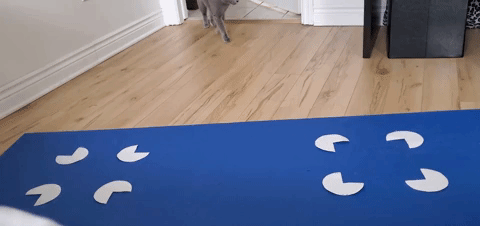Cats love boxes so much they'll even sit in fake ones

Anyone who owns cats knows they love to sit in boxes. Now a citizen science project suggests they like to seat themselves within the outlines of squares just as much as they would like to plant down in real ones, showing that cats (like their human owners) can be fooled by optical illusions.
The feline instinct to sit in boxes goes beyond house cats — Florida animal sanctuary Big Cat Rescue has shown lions, tigers, leopards, bobcats and lynxes are fond of boxes too. This urge, at times affectionately dubbed "if I fits I sits," isn't limited to 3D boxes — in 2017, cat fans posted a flurry of photos on Twitter revealing that simply taping the outlines of squares onto floors could prompt cats to step inside.
After hearing a lecture on how dogs reacted to visual illusions and returning home to play with her roommate's cat, study lead author Gabriella Smith, an animal cognition scientist at Hunter College's Thinking Dog Center in New York, "wondered if cats' tendency to sit in squares on the floor would extend to illusory squares," she told Live Science.
Related: 20 weird dog and cat behaviors explained by science
Smith and her colleagues focused on the so-called Kanizsa illusion. This involved arranging four "Pac Man" shapes — circles from which a wedge one-quarter the size of each circle is removed — to suggest the contours of a square.
The scientists reached out to more than 560 cat owners over Twitter to take part in the project. Over the course of six days, the volunteers used paper, scissors and rulers to create square outlines, the Kanizsa square illusion and a bunch of "Pac Man" shapes oriented in a way to not generate the illusion. To prevent the owners from accidentally influencing the cats in any way, they were instructed to wear sunglasses to hide their eyes.



Once the owners had taped the shapes onto the floor, they let their cats into the room. The volunteers then checked to see which shapes, if any, the cats sat in for more than 3 seconds within 5 minutes after entering the room, and they recorded the tests on video.
Sign up for the Live Science daily newsletter now
Get the world’s most fascinating discoveries delivered straight to your inbox.
"Due to known research that cats behave most naturally in familiar settings like the home, the citizen science format of this study was the perfect match," Smith said.
In the end, only 30 owners completed all the tests. Of these, only nine cats made at least one choice during the experiment. The researchers found the felines chose the illusory square seven times, nearly as much as the eight times the cats chose the real squares, "indicating that they were susceptible to the illusion," Smith said. The discovery "informs us about the evolution of their vision, specifically their sensitivity to contours and how it compares to humans and other animals."
Oddly, one time one of the cats, Totoro, chose the third "control" choice, where the Pac Man shapes were placed in a way that should not have generated an illusion. "It is unclear why this happened, though it could be explained as an attraction to the novel stimuli on the floor, and not necessarily attraction to any boxlike attributes of the control," Smith said.
The scientists noted they would have liked to look at more cats for the study. "If performed again, we'd aim to avoid participant attrition by shortening the study from its original six-day format," Smith said.
It remains a mystery what drives cats to sit in boxes, or real or illusory squares. "Cats may like boxes or laundry baskets due to the comforting pressure they provide," Smith said. Another possibility is that boxes may kindle a cat's instinct to ambush prey, she noted. The attraction to squares on a floor, real or illusory, may therefore stem from their instinctive weakness for boxes, Smith noted.
In the future, the researchers would like to see if cats are fooled by a 3D version of the Kanizsa illusion. They would also like to see if non-domesticated big cats are vulnerable to these illusions.
Smith noted she has a cat of her own, "a spunky, 1-year-old tabby named Pancetta who I adopted after I performed the study. I have not tried the test on her yet, although she is a big fan of new delivery boxes."
The scientists detailed their findings online April 30 in the journal Applied Animal Behaviour Science.
Originally published on Live Science.

Most Popular


